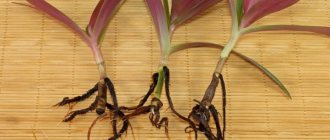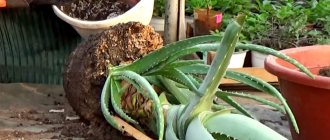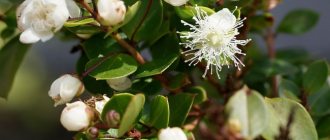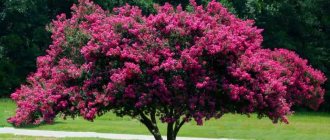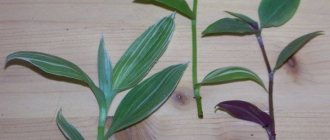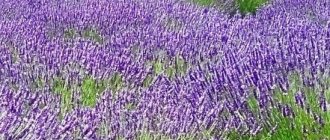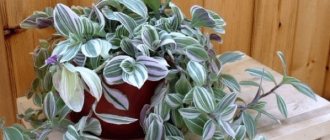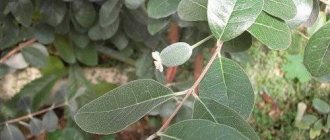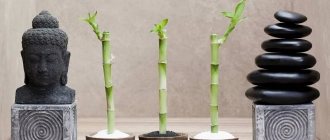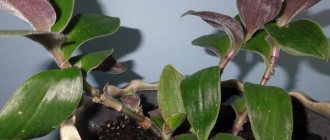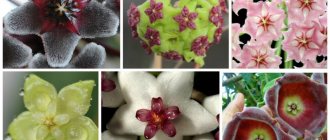Features of Tradescantia
Tradescantia is a not very tall herbaceous perennial plant that has creeping or straight stems. Alternately arranged leaf plates can have different shapes; depending on the type, it can be elliptical, lanceolate or ovoid. The formation of inflorescences occurs from the axils of the apical leaf plates. Tradescantia is one of the hanging plants that are most popular among gardeners. Thanks to regular pinching, the bush becomes lush and branchy. Most often, a pot with such a flower is placed on a high shelf or in a hanging vase so that the long stems can hang freely. During flowering, blue or violet-blue flowers form on the bush. Tradescantia is also used to decorate aquariums. To do this, the flower is placed in such a way that its stems are immersed in the water of the aquarium and form a green, spectacular mat.
This plant also has medicinal properties. It helps purify the air in the room and can also neutralize electromagnetic radiation. The cut branches of this plant, placed in water, can stand there for several months, and sometimes for about a year. But for this you need to regularly add fertilizer to the water.
Beneficial features
Since ancient times, Tradescantia has attracted flower growers not only for its subtle original beauty, but also for its medicinal properties:
- gardeners know it as a hemostatic and healing agent for skin damage;
- if you apply a fresh leaf to the sore spot and make a bandage, the wound will stop bleeding, swelling and bruising will decrease, and minor cuts and scratches will heal quickly;
- It is useful to periodically chew a Tradescantia leaf to prevent gum problems;
- alcohol infusions are used for lotions in the treatment of injuries and for rubbing sore spots;
- Tradescantia decoctions relieve the symptoms of colds, sore throat and acute respiratory viral infections (gargling).
But we should not forget that self-medication is extremely dangerous - preliminary consultation with a specialist is always necessary.
Returning home after a long day of work, you will be happy to relax in an atmosphere of coziness and comfort at the sight of well-groomed plants. If you are seriously interested in growing tradescantia, it will certainly become an indispensable addition to the collection of plants in the interior of your home or garden.
An excellent way to propagate Tradescantia in the video below.
Brief description of cultivation
- Bloom . Tradescantia is grown as an ornamental foliage plant.
- Illumination . Slight shading or bright, but necessarily diffused light. Please note that variegated varieties need more sunlight, but direct sunlight can damage them too.
- Temperature regime . In the spring and summer, the air temperature should be about 25 degrees, and in the cold season - no more than 12 degrees.
- Watering . During the growing season, water abundantly and systematically, immediately after the top layer of soil mixture in the pot has dried. During a cool winter, watering is carried out only when the substrate in the container is completely dry, but if the flower overwinters in a warm place, then it should be watered immediately after the earthen ball has dried to ¼ of its depth.
- Air humidity . Grows well at low levels of air humidity, typical for residential premises.
- Fertilizer . Fertilizing is carried out only in the spring-summer period regularly once every half month, while it is recommended to use organic matter and mineral fertilizers alternately. It is better not to feed variegated varieties with organic fertilizers.
- Rest period . It is not clearly expressed.
- Trimming . In spring time.
- Transplant . It is carried out together with pruning. Young bushes are replanted every year, and adult bushes - once every 2 or 3 years.
- Soil mixture . If you wish, you can buy a ready-made soil mixture for Tradescantia. But you can also make it yourself by combining turf, leaf and humus soil, as well as sand in a ratio of 2:4:2:1.
- Reproduction . By dividing the rhizome, cuttings and seed method.
- Harmful insects . Thrips, scale insects and spider mites.
- Diseases . If the plant is not properly cared for or is not provided with comfortable conditions for growth, then its shoots may become bare, rot may appear, and this also leads to the foliage becoming faded, or spots appearing on it, or its tips become brown.
- Properties . Tradescantia pallidum can cause skin irritation.
Tradescantia, the most compact and slow-growing variety!
